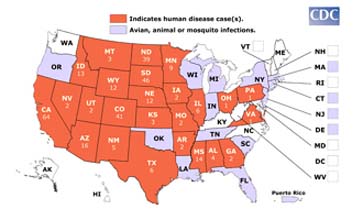West nile virus epidemiology and demographics
Editor-In-Chief: C. Michael Gibson, M.S., M.D. [1]
Overview
Epidemiology
The human case-fatality rate in the U.S. has been 7% overall, and among patients with neuroinvasive WNV disease, 10%.
In general, the WNV transmission season in the U.S. is longer than that for other domestic arboviruses and requires longer periods of ecologic and human surveillance.
1. Northeastern and Midwestern U.S.
In the northeastern states in 2001-2002, human illness onset occurred as early as early July and as late as mid-November. During these same years, avian cases occurred as early as the first week of April and as late as the second week of December. Active ecological surveillance and enhanced passive surveillance for human cases should begin in early spring and continue through the fall until mosquito activity ceases because of cold weather. Surveillance in urban and suburban areas should be emphasized.
2. Southern U.S.
In 2001-2002, WNV circulated throughout the year, especially in the Gulf states. Although, in 2001-2002, human illness onset was reported as early as mid-May and June and as late as mid-December, equine and avian infections were reported in all 22 months of the year. Active ecologic surveillance and enhanced passive surveillance for human cases should be conducted year round in these areas.
3. Western U.S.
In 2002, WNV activity was first reported among humans and animals in Rocky Mountain states and among animals in Pacific coast states. These events occurred relatively late in the year (mid-August). Predicting the temporal characteristics of future WNV transmission seasons based on these limited reports is not possible. Despite this limitation, active ecological surveillance and enhanced passive surveillance for human cases beginning in early spring and continuing through the fall until mosquito activity ceases because of cold weather should be encouraged.
4. Other Areas of the Western Hemisphere
In 2002, Canada experienced a WNV epidemic in Ontario and Quebec provinces and an equine/avian epizootic that extended from the maritime provinces to Saskatchewan. Recent serologic evidence supports the conclusion that WNV has now reached Central America. Further spread to South America by migratory birds seems inevitable, if this has not already occurred. Development of surveillance systems capable of detecting WNV activity should be encouraged in the Caribbean and Central and South America. WNV surveillance should be integrated with dengue surveillance in these areas, and with yellow fever surveillance in areas where urban or peri-urban transmission of this virus occurs.
Demographics

Map shows the distribution of avian, animal, or mosquito infection occurring during 2007 with number of human cases if any, by state. If West Nile virus infection is reported to CDC from any area of a state, that entire state is shaded.
Data table:
Avian, animal or mosquito WNV infections have been reported to CDC ArboNET from the following states in 2007: Alabama, Arizona, Arkansas, California, Colorado, Connecticut, Delaware, Florida, Georgia, Idaho, Illinois, Indiana, Kansas, Louisiana, Massachusetts, Michigan, Minnesota, Mississippi, Missouri, Montana, Nebraska, Nevada, New Jersey, New Mexico, New York, North Dakota, Ohio, Oklahoma, Oregon, Pennsylvania, Puerto Rico, South Carolina, South Dakota, Tennessee, Texas, Utah, Virginia, Wisconsin, and Wyoming.
Human cases have been reported in Alabama, Arizona, Arkansas, California, Colorado, Georgia, Idaho, Illinois, Iowa, Kansas, Minnesota, Mississippi, Missouri, Montana, Nebraska, Nevada, New Mexico, North Dakota, Ohio, Pennsylvania, South Dakota, Texas, Utah, Virginia, and Wyoming.[2] [3]
West Nile virus has been described in Africa, Europe, the Middle East, west and central Asia, Oceania (subtype Kunjin), and most recently, North America.
Recent outbreaks of West Nile virus encephalitis in humans have occurred in Algeria (1994), Romania (1996 to 1997), the Czech Republic (1997), Congo (1998), Russia (1999), the United States (1999 to 2003), Canada (1999–2003), and Israel (2000).
Epizootics of disease in horses occurred in Morocco (1996), Italy (1998), the United States (1999 to 2001), and France (2000). In 2003, West Nile virus spread among horses in Mexico.